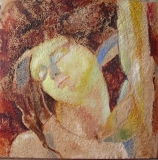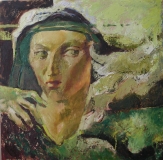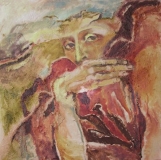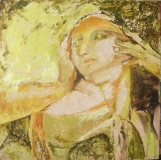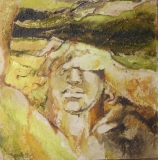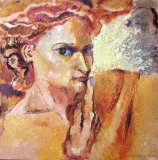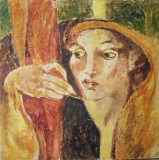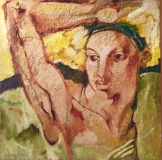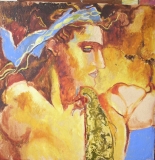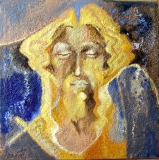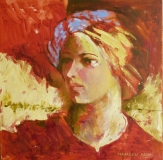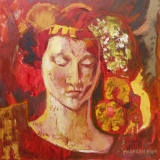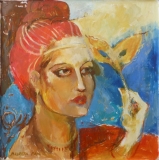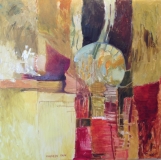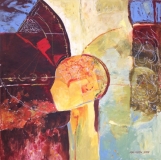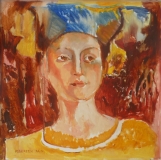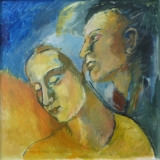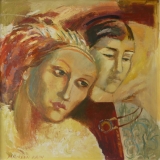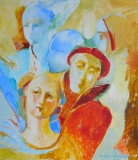I live in Jerusalem, and during the time of the British Mandate a law was passed stating that all buildings have to be faced in Jerusalem stone, to preserve an aesthetic unity in the city. The quarries rough-cut the rocks, and when I first arrived in Israel in 1969 one would see stonemasons on building sites chipping away for endless days to give definition & shape to the stones. A very fine powder is produced when the stones are cut, and I decided to add this to gesso to see what effects I could achieve. I laid down three layers of this ground on plywood, letting each layer dry. I sanded down some areas so that they were smooth, leaving other areas rough. The board looked like a stone, and in fact was almost as heavy!
The results were wonderful. The texture was inviting, and thrilling. As with watercolors, I could lightly stain (using turpentine not water of course), I could glaze, I was faced with unexpected surprises where the paint sank into crevices and created interesting textures which I could transform into motives. Because the basic color of the stone itself is a creamy white flesh tone, I could leave entire areas unpainted, as with watercolor, when painting the nude. This can be seen in the painting “African Sybil”, where much of the painting is “drawn” with a brush and left unpainted. You can see my method of working : a light sketch as a starting point, and in this case the painting did not demand the heavy layers which I used in “Amazon”. In “Amazon” for example, one can see that I re-worked and overpainted the hair, hand and collar of the garment many times.
In certain works I had to actually push or scrub the paint down to the board’s surface to create a base color, then added extra color by skimming along the raised rough surface, as seen in “Speak no Evil”. The hair started off as an umber underpainting, went through many stages and finally became this rich medley of colors. This is an oil impasto variation of a watercolor technique – layering colors to get a gradated different color.
The surface created its own momentum. A dialogue was born in which the surface inspired compositional solutions and creative inventions. I could use sandpaper to remove areas and I could use heavy impasto wherever I needed to. The rough surface would “catch” the color and so I could use three-dimensional layers. Shallow “craters” in the surface would suggest the placement of the features. The surface is so integrative, versatile and adaptable that I have been using it for ten years, and the surface has in fact inspired my recent themes.
Because the works reminded me of frescoes, I was drawn to the classic past. I began looking at photographs of Roman wall-paintings and Renaissance frescoes. There were angels, muses, nobles. The flaked paint and evident history of aging and restoration was similar to the effect that I wanted to create in my paintings. There was a special look in the eyes, a seriousness. There was the timeless presence. I have always loved painting portraits, and I was fascinated by the proportions that make a “classic” face. Was it the pose or the theatrical gesture that helped make it recognizably “classic”?
Text quoted from article by Maureen published in “The Artist Magazine”, Muses on Stone.

